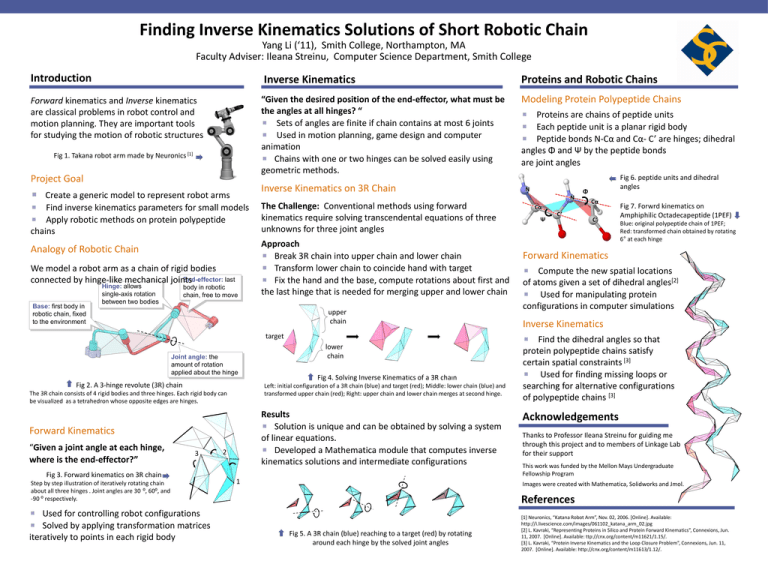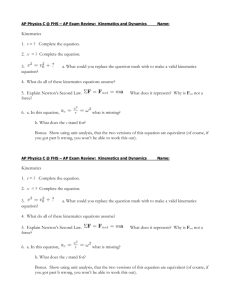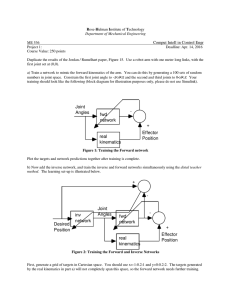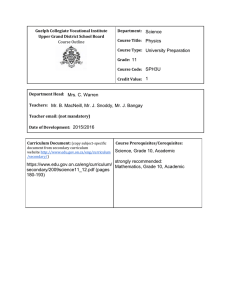Finding Inverse Kinematics Solutions of Short Robotic Chain
advertisement

Finding Inverse Kinematics Solutions of Short Robotic Chain Yang Li (‘11), Smith College, Northampton, MA Faculty Adviser: Ileana Streinu, Computer Science Department, Smith College Introduction Inverse Kinematics Proteins and Robotic Chains Forward kinematics and Inverse kinematics are classical problems in robot control and motion planning. They are important tools for studying the motion of robotic structures “Given the desired position of the end-effector, what must be the angles at all hinges? “ Sets of angles are finite if chain contains at most 6 joints Used in motion planning, game design and computer animation Chains with one or two hinges can be solved easily using geometric methods. Modeling Protein Polypeptide Chains Fig 1. Takana robot arm made by Neuronics [1] Project Goal Create a generic model to represent robot arms Find inverse kinematics parameters for small models Apply robotic methods on protein polypeptide chains Analogy of Robotic Chain We model a robot arm as a chain of rigid bodies End-effector: last connected by hinge-like mechanical joints Base: first body in robotic chain, fixed to the environment Hinge: allows single-axis rotation between two bodies body in robotic chain, free to move Inverse Kinematics on 3R Chain The Challenge: Conventional methods using forward kinematics require solving transcendental equations of three unknowns for three joint angles Approach Break 3R chain into upper chain and lower chain Transform lower chain to coincide hand with target Fix the hand and the base, compute rotations about first and the last hinge that is needed for merging upper and lower chain upper chain target lower chain Joint angle: the amount of rotation applied about the hinge Fig 2. A 3-hinge revolute (3R) chain Left: initial configuration of a 3R chain (blue) and target (red); Middle: lower chain (blue) and transformed upper chain (red); Right: upper chain and lower chain merges at second hinge. The 3R chain consists of 4 rigid bodies and three hinges. Each rigid body can be visualized as a tetrahedron whose opposite edges are hinges. Results Solution is unique and can be obtained by solving a system of linear equations. Developed a Mathematica module that computes inverse kinematics solutions and intermediate configurations Forward Kinematics 3 Fig 3. Forward kinematics on 3R chain Step by step illustration of iteratively rotating chain about all three hinges . Joint angles are 30 ⁰, 60⁰, and -90 ⁰ respectively. Used for controlling robot configurations Solved by applying transformation matrices iteratively to points in each rigid body 2 1 N N Cα Ψ C’ Fig 6. peptide units and dihedral angles Φ Cα C’ Fig 7. Forwrd kinematics on Amphiphilic Octadecapeptide (1PEF) Blue: original polypeptide chain of 1PEF; Red: transformed chain obtained by rotating 6° at each hinge Forward Kinematics Compute the new spatial locations of atoms given a set of dihedral angles[2] Used for manipulating protein configurations in computer simulations Inverse Kinematics Find the dihedral angles so that protein polypeptide chains satisfy certain spatial constraints [3] Used for finding missing loops or searching for alternative configurations of polypeptide chains [3] Acknowledgements Thanks to Professor Ileana Streinu for guiding me through this project and to members of Linkage Lab for their support This work was funded by the Mellon Mays Undergraduate Fellowship Program Images were created with Mathematica, Solidworks and Jmol. ç √ Ω “Given a joint angle at each hinge, where is the end-effector?” Fig 4. Solving Inverse Kinematics of a 3R chain Proteins are chains of peptide units Each peptide unit is a planar rigid body Peptide bonds N-Cα and Cα- C’ are hinges; dihedral angles Φ and Ψ by the peptide bonds are joint angles Fig 5. A 3R chain (blue) reaching to a target (red) by rotating around each hinge by the solved joint angles References [1] Neuronics, “Katana Robot Arm”, Nov. 02, 2006. [Online]. Available: http://i.livescience.com/images/061102_katana_arm_02.jpg [2] L. Kavraki, “Representing Proteins in Silico and Protein Forward Kinematics”, Connexions, Jun. 11, 2007. [Online]. Available: ttp://cnx.org/content/m11621/1.15/. [3] L. Kavraki, “Protein Inverse Kinematics and the Loop Closure Problem”, Connexions, Jun. 11, 2007. [Online]. Available: http://cnx.org/content/m11613/1.12/.





